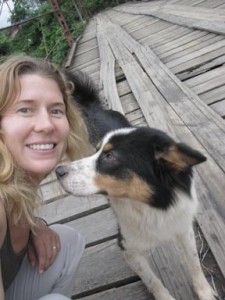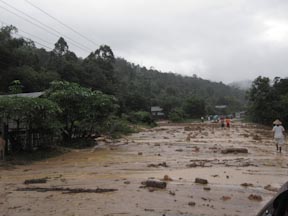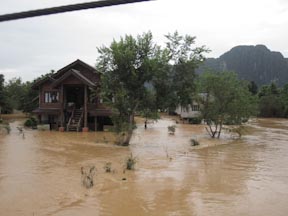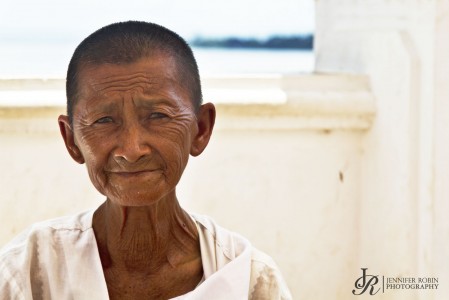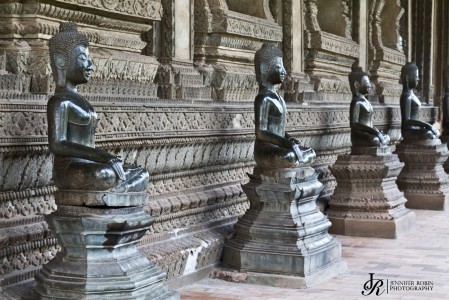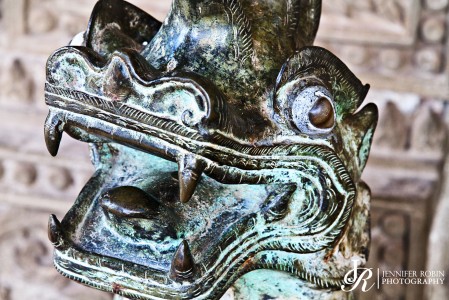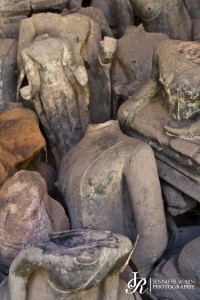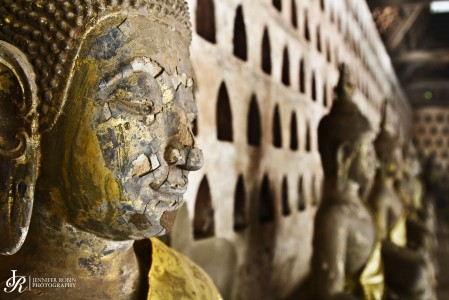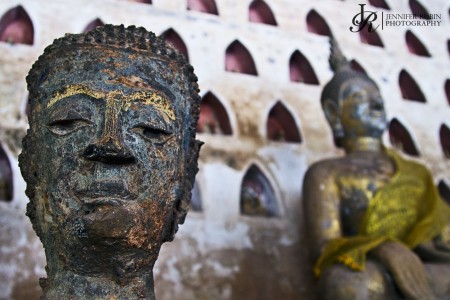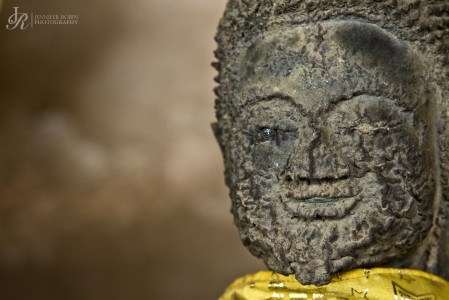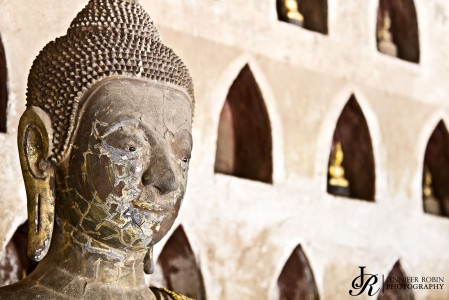Journey to Vang Vieng
Getting to Vang Vieng from Phonsavan proved to be more of a novel than the intended short story; although it started with the promise of being our best minibus ride ever.
At 8:30am, our minibus started rolling out of Phonsavan. It was a clean, new twelve-passenger van; with comfortable seats and a driver that actually drove with concern for road conditions, pedestrians, and our spinal columns. There were only four passengers on board – not the usual twelve-plus. They were Jen, me, and a young Brit guy and Australian girl who were traveling together. This was everything that our previous over-crowded, broken-down, bone-jarring, life-risking bus rides had not been. I was giddy.
Well, I was giddy until 11:00am. That’s when we hit the first mudslide.
 You see, it had been raining pretty good for a few days, as a tropical storm passed over northern Laos. It peaked the night before we left Phonsavan, causing mudslides and swollen rivers and streams; none of which work well with the narrow, two-lane roads that wind through the mountains of northern Laos.
You see, it had been raining pretty good for a few days, as a tropical storm passed over northern Laos. It peaked the night before we left Phonsavan, causing mudslides and swollen rivers and streams; none of which work well with the narrow, two-lane roads that wind through the mountains of northern Laos.
Jen and I were oblivious to all this, having dutifully ignored news and television and weather reports.
So, here we were, two and a half hours into what should have been a five-hour trip; in a line of buses and minivans and pickups and songtheuws; stacked up behind a mudslide at the crest of a peak.
At its deepest, the mudslide had put about six feet of mud across a hundred meter stretch of the asphalt roadway. In the middle of this was a Chinese cargo truck that had become stuck after making a foolish attempt to press through. With a steep embankment on one edge of the roadway, a steep drop-off on the other, and no alternate routes to bypass the mess, the only option was to wait for the route to be cleared.
To that end, a piece of heavy equipment was cutting a path between the Chinese truck and the embankment. What it was not doing was removing the several-feet-deep layer of mud from atop the roadway. Maybe that was because it was a bucket and not a blade, but even to laymen like us it looked like a key requirement was being overlooked.
Once the lane was cut, a gang of fifty or more men and boys from the closest village attached ropes to the undercarriage of vehicles on the opposite side of the mudslide from us, and began pulling them through one at a time. They were successful, but it was taking about fifteen minutes to clear each vehicle. Given the number of vehicles on both sides of the mudslide, it was obvious that – even if the human sled team had herculean endurance – it would be a very, very long time before all the vehicles cleared the obstacle.
Eventually, a bulldozer arrived and improved things a bit, but left before it made a substantial improvement. No effort was made to extract the stuck Chinese truck, though that would have simplified the problem.
The technique eventually employed to get through the mud lane was to drive into it as fast as possible, hoping for momentum to carry the vehicle to the other side. Members of the human sled team would stand on the sides of the lane, with only inches to spare between them and a speeding mass of metal. If the vehicle didn’t make it all the way, the sled team would attach ropes and start pulling. It was insanely unsafe. That no one was killed – to our knowledge – is a miracle.
Our minibus parked about a hundred-and-fifty meters from the mudslide. Jen and I would occasionally get out and walk up to check progress, and then grab beer from an enterprising woman who had set up a makeshift food and drink operation near the obstacle. Back at the minibus, we shared beer with the Brit-Aussie couple.
For additional entertainment, we broke out the Mac computer and watched “Life of Brian” and a couple episodes of “It’s Always Sunny in Philadelphia.”
 For food, we primarily relied on Jen’s snack stash, which she acquires before each bus trip. This time, we had crackers and dried seaweed, which we shared with the driver and other passengers. We also snagged some ramen-in-a-bag from the beer lady, which is still causing us both significant intestinal issues.
For food, we primarily relied on Jen’s snack stash, which she acquires before each bus trip. This time, we had crackers and dried seaweed, which we shared with the driver and other passengers. We also snagged some ramen-in-a-bag from the beer lady, which is still causing us both significant intestinal issues.
Throughout the long wait, it continued to rain. This meant a lot of sheltering in the minibus. It also meant that bathroom breaks in the bushes involved ankle-deep wades through muck. The floor of the minibus became a mess.
Eventually, well after dark, it was our turn to clear the mudslide. The driver floored the gas peddle, smashing into the mud lane and bouncing our heads into the ceiling of the van, but managing to get to the other side.
It was now 9:00pm. We had been stalled for ten hours.
Now moving again toward Vang Vieng, we hit thick fog. It was so thick that the driver left the road at one point, mistaking a driveway for the road. We all started thinking things were getting too dicey. As we passed through a town with a couple of guesthouses, we had the driver stop and call his dispatcher to discuss staying for the night. The dispatcher said that the route was clear the rest of the way to Vang Vieng, that we would soon escape the fog, and that the driver was capable of handling things. So, we continued.
The fog did clear, and the driver was capable, but the route proved not to be clear. We hit a second and third mudslide that caused us to stop, wait, then charge through. The fourth mudslide, however, caused our driver to throw in the towel until daylight. We turned to catching some sleep in the van.
It was now 2:00am.
 At 6:00am, after a marginally successful effort to sleep two people on one bench seat, the driver got the van through the fourth mudslide.
At 6:00am, after a marginally successful effort to sleep two people on one bench seat, the driver got the van through the fourth mudslide.
A few minutes later, and about ten kilometers from our destination, we hit a fifth mudslide. Parts of this one had swept through a village, strewing large rocks in the roadway. Just past the village, it had dumped about a four-foot-thick layer of mud, logs, and rocks along a hundred meter length of roadway. It was not something that would be cleared without heavy equipment, and we had already seen how effective that had been employed at the first mudslide. It would be hours to get through.
That’s when Jen and I prepared our packs to march into Vang Vieng, and said goodbye to our fellow minibus travelers. Other Westerners had previously abandoned their buses and vans to do the same thing, but it wasn’t until this mudslide that we also threw in the towel.
It was still raining, and we didn’t know if we would have to hike all the way to Vang Vieng, or if we would run into an opportunistic songtheuw or tuk-tuk driver along the way. As it turned out, we immediately ran into an opportunistic minibus driver on the other side of the mudslide, who drove us into Vang Vieng and dropped us at the Elephant Crossing Hotel (click here to read about the hotel).
We arrived in Vang Vieng a little past 8:00am – almost 24 hours after we had left Phonsavan.
By the way, this again speaks to the value of having your own wheels in Laos, either a dirt bike or a four-wheel-drive vehicle with high clearance. Both of these type rigs easily cleared the mudslides. The low-clearance, two-wheel-drive, public transportation did not.
Vang Vieng
 Vang Vieng is in a beautiful setting – a river, beautiful karst formations, small villages nearby. There is much to do in the surrounding countryside – kayak, climbing, and caves.
Vang Vieng is in a beautiful setting – a river, beautiful karst formations, small villages nearby. There is much to do in the surrounding countryside – kayak, climbing, and caves.
Despite this – or because of this – it has all the things we most dislike about a tourist town.
Vang Vieng is to Laos what Pai is to Thailand – only worse.
College-aged kids – mostly Brit, Aussie, and American – run around scantily clad. At the main intersection in the tourist center, we saw over 200 pass by during the course of a quick lunch, and this was during the off season. Bars and restaurants openly advertise drinks and food laced with opium, pot, and meth. Restaurants and hotels are geared toward the young Western knuckleheads that have turned the place into a teeny-bopper party spot.
With over a hundred guesthouses now crowding Vang Vieng, and more being built, one can only imagine the stupidity that runs rampant during the main tourist season.
Having now seen it, I would say that Vang Vieng is a place to be avoided by any person having reached any level of adult maturity.
But, having found ourselves there, we tried to find some goodness in the place. We rented a motorbike, and pressed as far as washed-out bridges would allow on the 33-kilometer loop west of town. It was a wonderful mud slog, and I think I am getting closer to earning my Laotian motorbiking merit badge. I even received an enthusiastic thumbs-up from an old guy who watched me clear a large mud field in the middle of the road, which I later cleared again with Jen on the bike.
By the time we were done, the bike was covered in brown. Best of all, the mud is a combination of mud and manure, which significantly increases the entertainment value.
On the food side, we discovered not one place worthwhile in Vang Vieng. All the food sucked and was over-priced. There may be a place or two outside of town where the locals eat that is actually good, but we could find no such place in the touristy center.
Overall, Vang Vieng is a town tarnished by the worst kind of tourism – the kind that turns a place into a party spot for foreigners; the kind that sends a message to other towns that tourism is something to discourage.
Vientiane
 We traveled from Vang Vieng to the capital city on a VIP bus, meaning a private company bus geared towards tourists. It was a 45-passenger bus, on which 44 of the passengers were Westerners, of which only Jen and I were over the age of 25. That pretty much tells you the tourist demography of Vang Vieng.
We traveled from Vang Vieng to the capital city on a VIP bus, meaning a private company bus geared towards tourists. It was a 45-passenger bus, on which 44 of the passengers were Westerners, of which only Jen and I were over the age of 25. That pretty much tells you the tourist demography of Vang Vieng.
On the plus side, the bus was in OK shape, the ride was smooth, and Westerners don’t seem to have the Laotian tendency to vomit on a bus.
At the Vientiane bus terminal, we went through the typical just-arrived disorientation, which the taxi and songtheuw drivers try to exploit to get you into their rig as fast as possible.
We got onto a songtheuw with three of the youngsters from Vang Vieng, which dropped us at the Hotel Khamvongsa, where we stayed the next three nights (click here to read more about the hotel).
Over the next three days, we walked all over the central part of Vientiane.
Vientiane is expensive in comparison to the rest of the country. For the first time, I had to learn to talk money in terms of hundreds of thousand of Kip. That pretty much says it all.
 There isn’t an excessive amount of sights to see in Vientiane, and we saw what interested us without difficulty in just a couple of days – all on foot.
There isn’t an excessive amount of sights to see in Vientiane, and we saw what interested us without difficulty in just a couple of days – all on foot.
One of the things that interested us was the National Museum.
The National Museum is a long, long ways from being the Smithsonian Institute. It’s in a run down building, and the exhibits reminded me of entries in a junior high school history fair. An example would be the tiny dinosaur exhibit, which had a bone in a case, and a framed poster of dinosaurs suitable for a second grade classroom. So, as a museum, it ain’t that impressive.
But as an insight into how the Laotian’s view the Indochina Wars – and America’s role, in particular – it’s very interesting.
At least half of the building is dedicated to a chronology of the Laotian people’s (read communists’) struggle against French colonization, the struggle against the subsequent American-backed government that opposed the communists, and the final seizure of power by the communists that resulted in the current governmental system. It is mostly told by way of photographs, with captions underneath containing phraseology like, “…the puppet government of the American imperialists…”
The thing that most struck me was that the American bombing campaign in Laos was portrayed as an effort to destroy the Laotian communist forces and the areas they controlled – as an attack on the Laotian people – and not as an effort to interdict the flow of North Vietnamese military personnel and equipment into South Vietnam. There was no mention of the Ho Chi Minh Trail, at all. American military involvement in Laos was depicted as a war against the Laotian people – not North Vietnam – with the Laotian communist forces as their heroic protectors.
This is a significant difference in storylines, which portrays Laos as the primary target of the American war effort – not as an unfortunate third party caught between two rivals.
Given that the museum is almost certainly portraying the sanctioned storyline, and therefore the storyline fed to the public, it becomes less of a mystery as to why Laotians have preponderantly been cool and indifferent to us. The American military involvement is still very much part of living memory, and most of the areas we have visited so far were center mass of the US bombing campaign against the Ho Chi Minh Trail.
So, the museum may not be the Smithsonian, but it’s still worth a look.
Other things about Vientiane…
The main tourist concentration is in the central district, near the riverfront. Here you find all the guesthouses and bars and restaurants catering to Westerners.
Based on our sampling of restaurants, most of those in the main tourist spot are excessive on cost and skimpy on quality. Some of the places at which we ate are…
– Sticky Fingers Cafe and Bar; which is a high-priced, touristy joint lacking in any redeeming qualities (click here).
– Vieng Sawan Restaurant; which is a good option for meat-eaters who are looking for low-cost food popular with locals (click here).
– Fathima Restaurant; which serves good Indian fare with a tourist price tag attached (click here).
– Ban Villaylac Restaurant; which – while excessive on price – was superior in quality (click here).
A thing we noted in the tourist area of Vientiane, which we had not noted elsewhere in Laos, was begging. This was not the passive type of begging where someone puts out a coin cup and plays an instrument; but the aggressive type where someone approaches you at your table while you are eating outside, or pounds on the window while you are eating inside. We even had a woman with a toddler in her arms go to her knees at the opening of a food stall, start pleading to us, and get her child to cry on command to make it all the more dramatic. So, if you eat at a Western-oriented restaurant – particularly outside, and particularly at night – be prepared.
Overall, Vientiane is no more interesting than smaller towns we visited in Laos, but noticeably more expensive. That’s not to say it isn’t worth a visit. Just don’t expect it to be more than what it is.
And, Next…
Next, we are heading back into Thailand, where we will cross through the Isaan area before crossing back into Laos to visit its southern areas. After that, Cambodia.
